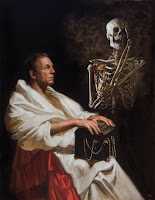"Auroch", Lascaux, France
(Public Domain Image)
Cave Story
Older than the quarried travertine
of the Colosseo, its predictable fall Rome's own
Eons before the rising of the Preseli Bluestones,
the fitted Sarsen stones of Merlin-magic renderings
into earthworked horseshoes and circles of Stonehenge
As famous as the Pyramids of Khufu and Giza,
holding a darker secret than the twenty-storey temple-steps
in the jungles of the Mayans' Teotihuacan
Are the hands of the nameless who drew
in the absence of God's own light,
their art discovered by four boys looking for a dog.
A bestiary in a cave in southwestern France, marching
along engraved and painted walls, on once pure-white
ceiling, in profile, broadly and rhythmically stroked
Abstract and representational, line stylized
and lively, masterly if rudimentary,
graceful, emotive, fully confident head-on
This plenitude of cows and horses, of bison
and mammoths and bears, of wolves
and cats, deer and lion, ibex and aurochs
The hunted and the feared, the eaten and the fought,
the Paleolithic, the pre-historic,
the very rare, a stick of a man with a bird
A cavalcade in reds yellows and browns
ochres and black and — yes, this surprise — a violet
raw colors, strong colors, mysteriously made colors
Applied, perhaps, with mats of hair, clumps of moss,
maybe blown directly from mouths,
through hollowed-out bone, by hands without brushes.
September, 1940, and four boys in Dordogne — Marcel
and Jacques, Georges and Simon — give chase and
the little dog Robot suddenly stops in its tracks.
Inside, on elbows and knees, down a shaft boys terrified slide
into the dark of 17000 years B.C., 20000 years B.C.,
and see for the very first time
Painters' deliberations of contours in The Hall of the Bulls,
outlines black-sketched of swimming deer,
ponies angled in a close-up frieze
of narrative we will never hear that yet made memory
In shaped-by-hand beauty, imprinting a pulse
like the boys' own oath of secrecy too soon given up to a line-up
charged forty cents per head per admission.
Sought out, old schoolmaster Laval advised "Don't touch"
and "Guard from vandals" and the boys, they tried,
but awe released in thousands and thousands of breaths
Exhaled on the property of the Count of LaRochefoucault
left Abbe Breuil's Sistine Chapel of Prehistoric Times ailing,
a bas relief of condensation, brown tears, a colony of stains.
Carbon dioxide was the killer, its first signs of Green Sickness
a lichen growth on walls, its next the White Sickness
of calcite on paintings, its next the attacks of fungi,
the algae and molds unstoppable
In the whir of compromised air conditioning, unsterilized shoes,
the suffocation by quicklime of cave floor, the invasive mechanics
of applied antiobiotic compresses and extracted bacteria roots.
Jacques the boy of 14 who first guarded Lascaux by day and night
turned chief guide and lived to see the cave he loved dying,
his menagerie of leaping stags and charging bulls
and galloping horses come to ruin.
© 2010 Maureen E. Doallas. All Rights Reserved.
____________________________
Notes
Known as the "Father of Prehistory",
Abbe Henri Breuil was a French priest and famed archeologist. One of the first persons to learn of the boys' discovery, he confirmed the authenticity and era of the Lascaux paintings and during his studies at the cave uncovered bone fragments and other evidence of humans' presence there.
The four boys who discovered Lascaux were
Marcel Ravidat,
Jacques Marsal, Georges Agnel, and Simon Coencas. They at first thought they had found a tunnel that local Montignac legend held would lead to a secret cavern containing hidden treasure. (The story of the legend is told in the Curtis book noted below; see page 81.) Jacques Marsal was employed as chief guide until his death in 1989.
Lascaux has been closed to the public since 1963.
The Cave Painters: Probing the Mysteries of the World's First Artists, by Gregory Curtis, on
GoogleBooks
* * *
This prose poem is my response to
High Calling Blogs' call for a Random Act of Poetry. The prompt was, simply, "take us to an ancient place". Not one to follow a crowd, I took the hint to "play around" and went to a time before the great civilizations in Egypt, China, India, Rome, and Greece.
HCB will be highlighting a selection of contributors and providing a list of links on Friday. If you want to come along, drop your own link in the comment box
here at
Seedlings in Stone by Thursday, May 20.

























